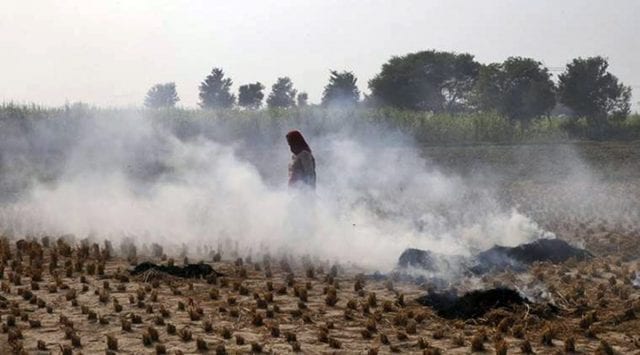The first six days of October saw five times the number of stubble-burning incidents in Punjab, Haryana, and Uttar Pradesh as in the corresponding period of last year, official data show.
In all, 1,091 incidents of crop stubble-burning were recorded in these three states between October 1 and October 6, the most for these dates since at least 2016, according to data collated by the Indian Agricultural Research Institute (IARI), Delhi.

Smoke from burning crop stubble contributes to air pollution over the national capital and large parts of the Indo-Gangetic plain every winter. Farmers burn paddy stubble around this time before they prepare the soil for the rabi crop.
The sharp spike in stubble-burning at the beginning of October this year comes after significantly fewer incidents on these dates (October 1-6) in 2019 (214) and 2018 (426).
ExplainedImpact on Delhi's air
Farmers in Punjab and Haryana burn paddy stubble around this time before they prepare the soil for the rabi crop. Smoke from burning crop stubble contributes to air pollution over the national capital and large parts of the Indo-Gangetic plain every winter.
Data compiled by IARI’s Consortium for Research on Agroecosystem Monitoring and Modelling from Space (CREAMS) Laboratory using satellite remote sensing technology, show that the largest number of residue-burning events during October 1-6 this year took place in Punjab – 841, more than 10 times the number of such events on these dates in 2019 (79).
A total 188 residue burning events were detected in Haryana, followed by 62 in UP between October 1 and 6 this year. The numbers were lower in both states during the corresponding period last year – 108 and 27 respectively.
Read | Delhi’s poor air struggle restarts
In Punjab, the largest numbers of residue-burning events this year were detected in Amritsar district (342), followed by Tarn Taran (205); in Haryana, Kurukshetra (56) and Karnal (38) saw the most farm fires. UP had scattered events.
Story continues below this ad
The residue burning has been detected in images received from seven research satellites — NASA’s Terra and Aqua; the US National Oceanic and Atmospheric Administration’s (NOAA’s) Suomi NPP, NOAA-18, and NOAA-19; and the European Space Agency’s (ESA’s) MetOp-1 and MetOp-2. The System of Air Quality and Weather Forecasting and Research (SAFAR-India), under the union Ministry of Earth Sciences, has forecast a deterioration of air quality in Delhi in the coming days due to the increased burning of stubble in Haryana and Punjab.
“The overall Delhi AQI (air quality index) is in the higher end (of the) moderate category as forecasted, and (is) likely to touch the poor category by late tonight,” SAFAR said in its short range forecast for Delhi on Wednesday. “AQI is forecasted to deteriorate for next 3 days and forecasted to remain in POOR category with increasing magnitude until 10th October,” it said.
Also read | Explained: From humble fungi, the promise of cleaner air in Delhi this winter
IARI Director Dr Ashok Kumar Singh said one reason for the increased number of farm fires could be a rush by farmers to prepare their fields to sow potato.
Story continues below this ad
“In recent years, the area under long-duration paddy varieties like PUSA-44 has come down, and the area under short-duration varieties such as Pusa Basmati-1509 and PR-126 has gone up in Punjab,” Dr Singh said.
“The short-duration paddy varieties are planted around June 15 and harvested by the third week of September, so farmers have about a month to manage the paddy straw before the next (wheat) crop is sown between November 1 and 6. However, farmers who want to grow potatoes try to prepare their fields early, as sowing of potato begins in the first week of October. In order to do this, they burn the paddy residue.”
However, Dr Singh said, the trend seen in the initial farm fires data may not hold – and the overall stubble-burning may end up being about the same as last year.








